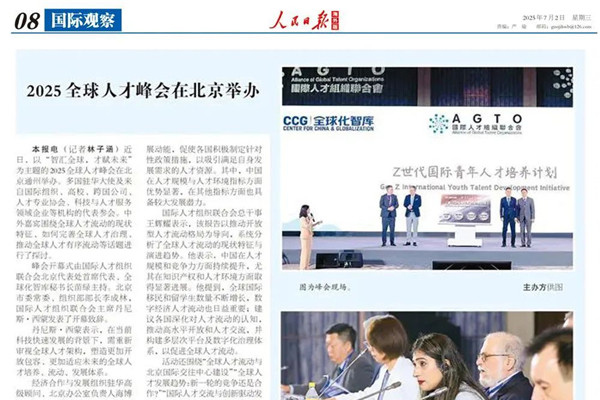-
【人民网】中国的出境人员成为世界第一大旅游客源
转载自人民网,2015年3月19日[人民网北京3月19日电]由中国与全球化智库(CCG)编撰、社会科学文献出版社出版的《中国国际移民报告(2015)》在京发布,蓝皮书报告认为:国际移民呈现相对集中的特征,亚洲人是国际移民最大群体,中国的出境人员成为世界第一大旅游客源。中国与全球化智库(CCG)指出目前中国国际移民形势呈现以下热点趋势,并就建立具有国际竞争力的人才移民体系,提出相关建议:1.国际移民呈现相对集中的特征,亚洲人是国际移民最大群体,经济危机刺激了国际移民的流动。2.中国的出境人员成为世界第一大旅游客源。3.中国移民美国人数连续两年递减,美国对移民的吸引力出现减弱现象。4.中国向主要发达国家移民人数基本保持稳定。5.投资移民将继续成为重要移民群体,对我国不会构成直接冲击。6. 来华移民成新热点,中国成为越来越有吸引力的移民目的国。7. 中国国际移民在带动中国企业国际化等方面的作用正在凸显。8. 10年有效签证政策将有效减少海外移民人数,建议将此签证便利化措施推广至更多国家。9. “移民红利”在发达国家科技和经济领域的表现突出,中国需进一步开发移民红利。10. 中国吸引海外人才的政策成效明显。11. 海外侨胞有助于推动“一带一路”战略。12. 建立具有国际竞争力的人才移民体系,开发好国际移民红利。13. 美国移民改革计划将对中国带来挑战,我国应积极探索技术移民事业,加强引进国外智力。14.移民融入问题越来越引起移民接受国的关注,我国应加强移民融入服务和非常规移民的管理,提升国际形象。
2015年3月23日 -
【光明日报】智库专家“把脉”世界新格局与中国发展
两会之后,中国经济发展会呈现哪些新特点?所面临的世界政治、经济、外交局势如何?政府、社会、企业等应当怎样应对?围绕社会关心的上述热点问题,中国与全球化智库(CCG)昨天在北京银泰中心邀请智库专家以“从两会看中国与世界经济发展”为题展开讨论。原国家外经贸部副部长、CCG咨询委员会主席龙永图,外交学院原院长和中国驻法国前大使、CCG顾问吴建民,香港恒隆地产董事长、CCG咨询委员会联席主席陈启宗,新加坡国立大学东亚研究所所长、CCG学术专家委员会主任郑永年分别作主题发言,60余位专家学者出席会议。CCG主任、国务院参事王辉耀主持会议。 龙永图在发言中指出,此次两会传递出几个清晰而积极的信息:再次重申了发展是硬道理,不盲目追求GDP不等于不要GDP;必须正视资源环境对发展的巨大压力,用全球眼光解决环境问题;以开放促改革是中国的成功经验,也将继续成为推动中国发展的强劲动力。 陈启宗简要介绍了欧盟、日本、非洲、东南亚等全球几大主要经济体的现状与前景,分析了它们与中国发展的密切关系。他认为,美国在未来十几年里会重新成为世界制造业最重要的国家之一。中国应在国际上广交朋友,使“世界的市场成为我们的市场”,在良好外交中加快发展步伐。 吴建民以“实事求是给人以希望”“中国已经迎来并投身资本国际化大潮”“做好准备迎接第四次创业热潮”为主线,与大家分享观点。他特别就“一带一路”战略发表看法,认为这是中国外交史上意义非凡的战略性倡议,实现此宏伟构想需要几代人的努力,这可为亚洲经济增长提供持久动力。 郑永年认为,十八大以来,中国新一届领导人正在从理念到实践,引领中国进入大变革时代。从政治领域的顶层设计到经济领域的放弃唯GDP论,改革蓝图已非常清晰。2015年全面深化改革前景光明,重在执行。 转载自《光明日报》2015年3月18日第二版要闻版,记者:王斯敏
2015年3月23日 -
浅谈智库公信力和智库人才
我们必须承认,随着中国经济和社会的发展、国家地位的提高,智库必将会大规模出现,所扮演的作用将越来越重要。特别中国国际经济交流中心的全球智库峰会,党 和国家领导人的积极参与就是很好的证明。但是,我们应该知道事物的发展是一个不断渐进的过程,中国的智库、特别是民间智库相对于西方国家来说起步较晚,它 的发展、成长和壮大需要一定的时间。最近几年来,我国智库的发展还是取得了令人欣喜的进展,其中,以2009年成立的中国国际经济交流中心为代表,我国的民间智库新一轮模式探索开始起航。同样,如中国与全球化智库(CCG)这样的以人才为特色的民间智库,越来越成为我国智库的一支生力军。CCG近两年陆续推出“中国留学发展报告”、“中国海归创业报告”“中国移民报告”等一系列国际人才蓝皮书,在国内外产生了强烈反响,引起社会的普遍关注。这些智库的出现,都为未来我国民间智库发展提供了一个很好的模式,成为我国民间智库成功发展的一个缩影。 随着我国智库从数量到实力的不断发展壮大,越来越多的智库活动出现在公众视野中,原来不知智库为何物的民众开始呼唤智库的公信力。智库之所以发挥巨大作用,得到民间认可,其中最为关键的一点是在保持学术成果高质量的基础上,保持智库的独立性,把“与政府保持紧密联系”与“研究成果的对立性”严格区分开来。同时,智库要注重学术成果的交流与宣传,采用多种手段和渠道向决策者、社会公众、学术圈和媒体、网络宣传推介他们的思想、观点和策略,逐步树立了自己的学术影响力、社会影响力和政策决策执行影响力,从而增强在民间的公信力。 要合理定位智库功能。对于政府的各项政策和目标,智库要从传统“解读”模式向“前瞻型建议”“、“可行性分析”和“执行性评估”三个方面转化,要把智库定位为决策者提供建议和素材,而不是制定政策。 青年人想成为智库的一员应该具备哪些素质?优秀的智库既要有优秀的研究人员,也需要优秀的管理人员和从事基础工作的辅助人员,要注重专才和通才的有效结合和 搭配,要发挥科技辅助人员、新闻媒体宣传人员和市场业务开发等在课题研究中的作用。对于研究人员来说,一个优秀的研究人员,既需要深厚的学术功底和研究能 力,也需要较好地管理能力和从事各项活动的交流能力,即我们常说的“两栖人才”。 对于一个年青人来说,要想成为一个优秀智库人才。要注意以下几个方面的培养:一是注重培养自己的学术功底,提高自己的科研能力;二是要培养自己良好的交流和沟通技巧;三是要培养熟练的国际语言交流的能力;四要有一定的管理能力。本文根据接受中国青年网采访的内容整理
2015年3月12日 -
【中国日报】Cooperation potential called ’limitless’
Scholars, government officials and company executives from China and the US got together Feb 26 and put their heads together at a three-day conference on how to better tap into the potential for China-US economic cooperation."I haven’t closed my eyes and slept in the past 48 hours due to the long flight and time difference, but I still feel energetic and excited, thinking of the great potential for cooperation between Chinese and US companies," Wang Jian, general manager of the corporate banking unit of Bank of China, told the conference when he arrived in San Francisco from Beijing on Feb 26.A Chinese delegation, headed by Wang and made up of more than 60 scholars and representatives of small-and medium-sized enterprises (SMEs), came to the Bay Area for the conference "Cracking the US Market: Opportunities & Threats for Chinese Multinationals," which was hosted by University of San Francisco and co-hosted by Bank of China and the city of San Francisco.Wang said the aim of the conference was to build bridges between Chinese and US companies in order to boost two-way investment and cooperation between the world’s two largest economies."China has a vast market and low-cost labor and materials, but its technology remains backward and the pollution issues need to be addressed as well," Wang said. "The potential for China and the US to complement each other’s strengths is beyond measure."Over the past few years, Wang’s unit has been conducting research on how to better assist Chinese SMEs on entering overseas markets, he said. They also organized a trip for entrepreneurs to visit European companies in 2013."We found they are very interested in the foreign companies’ advanced management and the technologies of reducing pollution and energy consumption," he said.His comments were echoed by California state senator Robert Herzberg, who also attended the conference."In the last few years, the number of businesses on the both sides has grown tremendously, particularly the Chinese businesses investing in America and California," said Herzberg, who has traveled extensively throughout China as an international business attorney."The real estate purchases in southern California and wineries in northern California," Herzberg said in an interview, "there are a lot of examples of companies working together. I think it’s going to grow and grow quickly."Thus far, however, there hasn’t been a platform for SMEs from both sides to establish dialogues and the Chinese SMEs have encountered various difficulties in going global, such as lack of information and opportunities, as well as high cost, said Wang Jian.With the number of Chinese enterprises coming to the US on the rise, their demands on supporting financial services will also increase, such as cross-border financing businesses and international trade settlements, according to Wang Huiyao, a professor attending the conference, who is also the founder and president of a Beijing-based think tank, the Center for China & Globalization."Bank of China will play a very important role in helping Chinese SMEs survive and thrive in the US market by bolstering their financial strengths," Wang said.Hertzberg also pointed out the importance for Chinese businesses entering the US market to better understand things like California’s unionized labor and labor laws."China has different kinds of labor laws, so it’s important for the Chinese companies that come here to understand how labor laws work and make sure they do their homework, just like the California companies who want to go to China, really need to understand how to do business in China," he explained."Another issue that needs addressing is hacking and technology, and this is going to take longer to actually build relationships, because there are other interests," said Hertzberg."But clearly in the real estate area, other manufacturing and the automobile business, there are great opportunities," he added.Last year, Chinese investments in the US reached $12 billion, topping the $10 billion mark for the second year in a row. In 2013, Chinese annual foreign direct investment (FDI) in the US exceeded the FDI of US companies into China."While the upward trend is expected to continue, there are many challenges and barriers," Chinese Consul General in San Francisco Luo Linquan told the conference. He said he hoped the participants would pool together resources to promote greater Chinese investment in the US.The conference touched upon such topics as innovation and sustainable growth of Chinese enterprises, patterns and trends in Chinese overseas mergers and acquisitions and challenges for incoming Chinese FDI. Business matching meetings were held on the sidelines between Chinese and the US entrepreneurs.
2015年3月3日 -
【中国日报】Foreign students receive up to 99,800 yuan aid
International students awarded Chinese Government Scholarships are receiving increased financial support following a change in the way the system works.The ministries of finance and education announced last month that the amount paid to an undergraduate has been increased to a maximum of 66,200 yuan ($10,660) a year. Master’s students receive up to 79,200 yuan, while doctoral students collect up to 99,800 yuan.The Ministry of Education said the new financial support standard applies to all scholarship recipients who have been studying in China since September, and arrears will be paid to reflect the increase.However, many universities have not yet taken any action in response to the change because of the winter holiday, which lasts from January to March.Previously, those awarded scholarships usually received free tuition, accommodations, textbooks and sometimes flight tickets, and were given a monthly stipend ranging from 1,400 yuan to 2,000 yuan.The increase was prompted by a number of factors, including the rising costs borne by Chinese higher education institutes that receive international students, the ministries said.The new standard divides scholarship holders into three types according to their majors: students majoring in philosophy, economics, the law, pedagogy, the liberal arts or management; those specializing in science, engineering or agriculture; and those studying literary theory or medicine.The level of support students receive varies depending on their major and stage of learning.Universities will keep some of the money to pay for tuition, accommodations and medical insurance, and give some to students each month to cover their living expenses. The latter amount ranges from 2,500 to 3,500 yuan a month after the increase.Shao Jiani, who is in charge of recruitment and management for the scholarship program at the University of International Business and Economics in Beijing, said the school was aware of the change but had not received any details."I believe more information will come after the new semester begins in March," she said.Sun Yuhong, deputy director of the Center for China and Globalization, a think tank in Beijing, welcomed the increase."The CCG has been calling for an increase in the financial support standard for some time, but we didn’t expect the change to come so soon," she said."The increase will definitely attract and encourage more international students and young scholars to study or carry out research in China, which will in turn promote the development of many fields of study in China."
2015年3月3日 -
【中国日报】For many of China’s biotech brains-in-exile, it’s time to come home
In biotech parks across the Yangtze River Delta, dozens of start-ups are working to develop drugs to treat China’s biggest emerging diseases - from diabetes and Hepatitis B to respiratory illnesses and cancer.It’s early days, but firms like Hua Medicine and Innovent Biologics embody China’s hopes for competitive biomedical innovation. And their Chinese-born, Western-educated founders represent the long-awaited return of the nation’s brightest life scientists.From school in the late 1970s and 1980s, when only elite students gained entry into China’s few biochemistry and molecular biology programs, they left China, graduated and worked their way up to senior positions in the world’s top pharmaceutical companies.It took the jobs squeeze of the 2008 global financial crisis and fresh government incentives - from state-of-the-art research labs to grants, loans and government venture capital - to prise them from international careers to launch their own start-ups in China."If returnees want to do innovation, in academia there is traditional resistance and old practices," said Huiyao Wang at the Center for China & Globalization. "It’s the private sector that really attracts people to start new ventures."China has committed more than $300 billion to science and technology, with biotech one of seven pillar industries in the latest Five-Year Plan. Biomedical research investment jumped more than four-fold in 2007-12, though it is still dwarfed by spending in the United States and Europe, according to a 2014 study in the New England Journal of Medicine.Returnee firms have listed in New York and London, work closely with ’Big Pharma’ and attract investment from US venture capital and multinationals."China is coming up, especially with returnees coming back. The innovation will come with the people," said Jimmy Zhang, a vice-president at Johnson & Johnson Innovation, which opened a regional center in Shanghai last autumn.China calling"I sometimes ask myself, ’why did I return to China?’ I had a very comfortable life in the US and my family’s still there," said Michael Yu, Innovent’s founder and CEO. "But for lots of Chinese men, there’s always something in the heart ... a desire to go back and do something. Biotech has only just started in China so you can have significant impact for a whole industry, for a country."After completing postdoctoral training at the University of California, San Francisco, Yu spent a decade at US biotech firms before going home in 2006 to co-found Kanghong Biotech, which developed the first homegrown innovative monoclonal antibody to be approved by China’s regulators. He later launched Innovent with funding from Chinese and US-based investors, including bioBAY, a government-funded biosciences park in Suzhou. BioBAY spent $140 million on Innovent’s 1 million square foot (92,903 square metre) laboratory and production facility.Another returnee, Li Chen, was chief scientific officer at Roche’s China R&D center when, in 2009, he was invited to dinner by US-based ARCH Venture Partners, which encouraged him to go out on his own. "It wasn’t something I was expecting," Chen said. He launched Hua Medicine in 2011 with $50 million from US and Chinese investors. Last month, it closed another $25 million in series-B financing.The returnee start-ups are leveraging shifts in the global R&D landscape. The financial crisis, expiry of blockbuster drug patents, and mega-mergers have forced major drugs firms to reprioritize, giving newcomers a chance to develop promising compounds already in the pipeline.Hua is about to launch Phase 2 trials for a novel Type 2 diabetes drug in-licensed from Roche. Zai Laboratory, another returnee firm, has an in-licensing deal with Sanofi to develop two compounds to potentially treat chronic respiratory diseases.By focusing on diseases that are on the rise in China, these firms can recruit from a vast patient population, speeding up the time it takes to conduct clinical studies.However, China’s regulatory environment, especially for drug approval, "has been quite inefficient and often inadequate," says Jonathan Wang at OrbiMed, a global healthcare-dedicated investment firm. Getting approval for human trials can take over a year, compared to just weeks in the United States."Everything else being equal, you’d go where the approval process is easier," said Wang.Empty nests and angel moneyFor some, coming home is as much a personal as professional issue. Many are ’empty nesters’ whose own children are now at college, or they have ageing parents."In the US, people have family and friends who can support them with ’angel money.’ As first-generation immigrants, we don’t have that kind of access there," said Zhang at J&J Innovation.For the returnees, it’s just the beginning."We’ve planted the seed for a fast-growing, innovation driven environment in China," said Steve Yang, chief operating officer at WuXi AppTec. "The impact of this group will be better measured in another 10-20 years."文章选自China Daily, 2015年2月13日
2015年3月3日 -
中国新闻网:中国富人向海外大学捐款难 批评因缺乏了解
【中新网纽约2015年2月25日电】中国与全球化智库和哥伦比亚大学社工学院共同举办的中美慈善研讨会24日在纽约举行。来自中美两地的二十多位慈善专家及学者出席论坛,并对中国即将启动的慈善立法提出建议。 与会的国际教育组织高级顾问Peggy Blumenthal在谈到时下一些中国富人向海外著名大学捐款时表示,公众对他们的一些批评其实是因为对捐款细节缺乏了解,他们给美国大学的捐款往往是指定给前来求学的中国学生,这些中国学生和美国同学相比,能够获得资助的途径很少。 其次,他们也不太可能凭借这些捐款来为自己的孩子“购买”一张录取通知书,尽管这可能为他们的子女将来申请入学带来一些加分,但如果申请人资质太差,美国的名校也不会录取他们。 Blumenthal表示,中国富豪向国内学校捐款少的原因之一是中国的大学长期以来习惯于接受政府拨款,很少向校友主动筹款,加上一些管理方面的不完善,这导致许多富豪不愿向他们捐款。这些都有待于逐步改善。 会议由中国与全球化智库副主任裔锦声女士主持,中国与全球化智库主任王辉耀博士和副主任孙玉红分别介绍了中国慈善事业的简要发展历程和中国的慈善法在过去十年的探索历程。 与会者认为,中国的慈善事业目前尚缺乏合理的基础设施,政策引导不足,专业的慈善机构也极少,亟需通过制定法律和普及教育等多种手段予以改进。 王辉耀博士表示,尽管目前存在很多不足,但随着中国慈善和非营利组织的蓬勃发展,中国首部《慈善法》的积极酝酿,中国慈善事业未来必将迎来大发展的时期。(文章选自中国新闻网,2015年2月25日)
2015年2月26日
© Copyright Center for China and Globalization 2008 — 2025 京ICP备09030466号-1 京公网安备11010502027417 Site Designed by MONOKEROS



